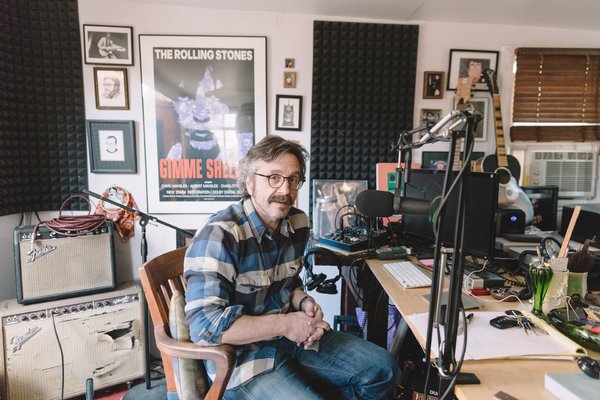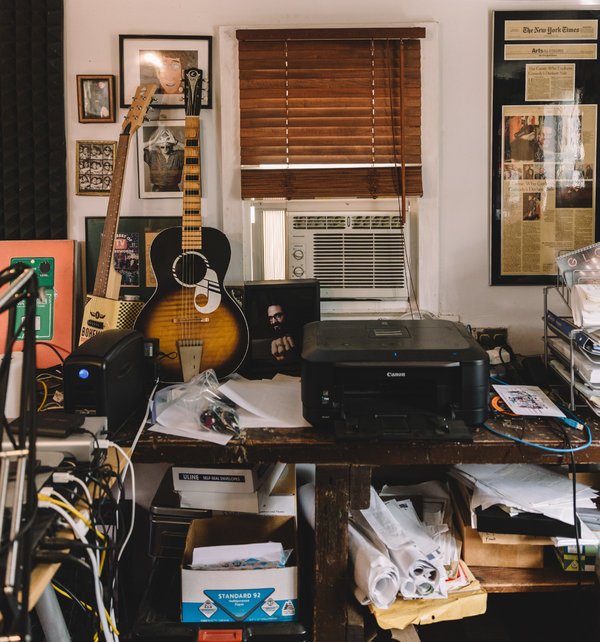
The end of an era: Marc Maron in the garage where he began the “WTF” podcast. CreditElizabeth Weinberg for The New York Times
Supported by
Photographs by
Feb. 28, 2018
LOS ANGELES — By the end of March, one of the most famous rooms in comedy will close its doors when Marc Maron leaves the garage where he taped interviews with the biggest stand-up and improv names, superstar actors and writers, even a president, for his essential podcast, “WTF.”
Mr. Maron, 54, who has recorded nearly 900 episodes, will continue to produce the podcast in a new garage in a more spacious, two-floor Craftsman home 10 minutes away, but make no mistake, an era is ending.
When he began broadcasting from this space in the Highland Park neighborhood here in 2009, Mr. Maron was a struggling stand-up comic experimenting with a niche form. His intimate conversations turned the garage into a confessional booth for comics, one where Todd Glass came out of the closet, Robin Williams movingly grappled with his depression and Carlos Mencia and Dane Cook addressed accusations that they stole jokes.
On the strength of his empathetic, probing interviews, he developed a loyal audience, helped popularize podcasts and played a critical role in the birth of the comedy boom. He also resuscitated his career. Now he’s a TV star (he just finished shooting the second season of the acclaimed Netflix comedy “GLOW”) and his stand-up shows fill theaters.

The garage itself has become as much of a character on the podcast as any of the guests. Mr. Maron has mythologized it as a magical and unlikely space, a dive alcove on a hill where guarded celebrities feel free to open up. Images of the garage show up in press photos, but it is perhaps most vivid in the imaginations of his regular listeners. On a recent morning, Mr. Maron gave me a tour of this vanishing landmark, a nostalgic trip that took an aptly dramatic detour when his mother showed up.
Even after he made enough money to upgrade his relatively modest home, he stayed in part because of anxiety about his ability to recreate the garage that changed his life. But as he got older, the mess accumulating around his desk bothered him. “It started to look like a sad roadside attraction,” he said. “Dust and cobwebs. People were going to be like: This is weird and gross.”
Mr. Maron, standing near stacks of “Please Kill Me,” the classic oral history of punk rock he often gives to guests, sounded slightly embarrassed to admit that he wanted a little comfort. Or at least a bathroom, so guests wouldn’t have to use the one inside his home, a sticking point with girlfriends in the past. He says he’s excited to start from scratch, and I couldn’t help but notice the room he’s leaving doubled as a shrine to his past.
Along with myriad fan-made portraits, he’s surrounded by photos of relatives and former loves and mementos from botched relationships (the Air Canada receipt accidentally sent to his first wife for a flight to see the woman who’d become his second). There are also awards (a medal from The Harvard Lampoon) and posters from comedy specials like his HBO half-hour (“I was sweaty and weird, and in retrospect it wasn’t great.”)
He’s thinking about getting rid of some of this stuff in the move, he said, taking out the letter from Mr. Cook making nice after a contentious episode as well as the photo of his second wife. “I don’t think I’m going to put her up,” he said. “She got me sober, so once a year I call to say thank you. Last year, she said, ‘If I wanted to hear from you, I’ll let you know.’ Oh, I’m that guy. I don’t want to be that guy.”
Mr. Maron pointed to a baby photo, this one of his mother, Toby Maron, in a leather chair holding him, gazing at her son with a raised eyebrow. He imagined what she was thinking: “How do I do this?” he said, adding, “She never figured it out.”
As it happened, his mother, 76, was visiting from Florida and minutes later, she called and he told her to come on over. After arriving wearing a “GLOW” jacket, she sat in the guest’s chair. “It’s so uncomfortable, I really couldn’t believe it,” she said. “All these big people sat in that chair, it is beyond my comprehension.”
Before he rebuilt his life in the garage, Mr. Maron considered ending it there. He began his podcast after his second marriage fell apart and his career was languishing. “I was miserably depressed and thought if this doesn’t work, I’ll kill myself in here,” he said, pointing to where he contemplated suicide, inches from where former President Barack Obama sipped tea. He has enough distance from that now to crack a joke: “But I always think about suicide, because I find it relaxing.”
On the wall behind the guest’s chair sits a paper with a list of good and bad traits he inherited from his father, Barry Maron. The “Barry Curses” part includes “worry,” “unable to hide himself” and “suicide.”
“He would leave the house with a gun in his hand and swear he would not come back,” Ms. Maron said about her ex-husband, who is still alive, then nodded to her son. “It’s much harder coming from him.”
Mr. Maron said he would keep his secondhand bookshelf with the “L.A. County Mental Health” sticker that he never peeled off. The new place has more light and higher ceilings, but Mr. Maron emphasized that it wasn’t a studio. “It’s still difficult,” he said. “I’m still going to deal with people working on the yard outside.”
Toward the end of the interview in his garage, Ms. Maron said she had her doubts about the move. “How does this help?” he responded sharply, sounding exasperated but also clearly enjoying the comic potential of this clash. And yet, if this was a bit, she was committed to it: “This is such a special place,” she said.
Mr. Maron turned away from his mother and looked up in the air, this time sounding genuinely annoyed: “Jesus!”
Take a Closer Look: Photos From the Tour
Advertisement
Article source: https://www.nytimes.com/2018/02/28/arts/television/marc-maron-podcast-garage-moving.html?partner=rss&emc=rss
Speak Your Mind
You must be logged in to post a comment.